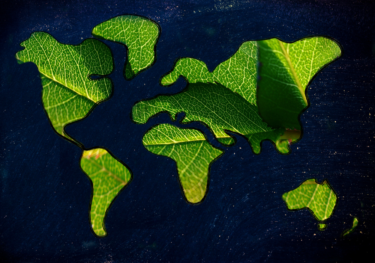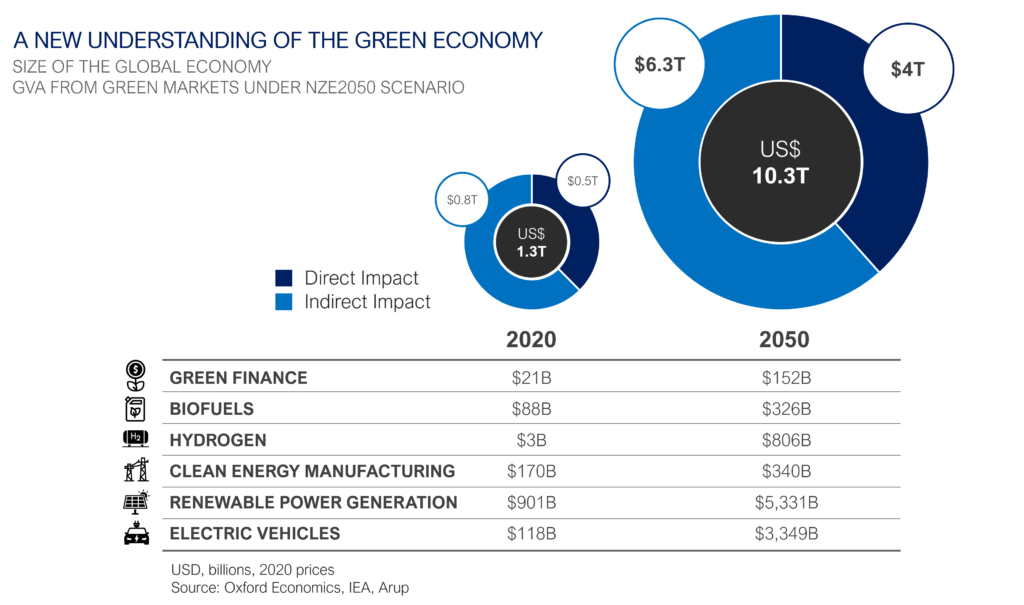Blog | 08 Nov 2022
$10.3 trillion: the value of the green economy opportunity

James Lambert
Director of Economic Consulting, Asia

Greening the global economy – an Arup / Oxford Economics advisory perspective series
The scientific consensus is clear: the impact of a failure to tackle climate change will be devastating. Higher concentrations of pollutants such as CO2 will push average temperatures up across the world, causing rising sea levels and extreme weather events that will in turn bring significant human suffering.
The economics are just as shocking. Economic modelling by Oxford Economics’ Global Climate Scenarios indicates that uncontrolled climate change would wipe 6.5% off economic activity by 2050. After 2050, the global GDP impacts grow even more severe.
Both outlooks point to the imperative for governments, businesses, and investors to take action. It will require a fundamental shift towards a greener economy — not just in the pivotal sectors of energy and transport, but across the entire economic spectrum, from the built environment to agriculture to financial services.
Rewards outweigh the costs
Just as climate action is urgently required to limit the extent of environmental damage, the economic opportunities implied by the green transition are urgent, too. Our economic analysis reveals that while climate change threatens to impose a huge cost, a successful coordinated impetus to build a green economy for a net zero future by 2050 will also deliver huge rewards.
Oxford Economics’ unique capabilities in macroeconomic forecasting, value chain modelling, detailed economic accounting, and quantitative analysis enabled us to quantify the size of the opportunity associated directly to the new markets for green goods and services that will emerge and their supply chains, which extend across the global economy.
We teamed up with Arup’s Strategy team to understand what the net zero transition requires on a practical basis, industry by industry, and built that into our economic model. In our novel, ground-breaking analysis, which will be published on 22 November, we estimate that the growth in demand for the new green goods and services that will facilitate the green economy will create an opportunity worth $10.3 trillion to 2050 global GDP, in 2020 prices. This is the equivalent of 5.2% of global GDP in that year.
As the chart below shows, the headline figure is made up of two contributions. The first is $4.0 trillion of value captured directly by those enterprises developing and producing the green goods and services we have identified. But this is greatly amplified by the $6.3 trillion coming from the wider supply chains of those industries. The opportunity is supported by two main planks: renewable power generation and electric vehicles manufacturing, which account for $5.3 trillion and $3.3 trillion, respectively.

We believe this is the first attempt to carry out such an economic modelling exercise on this scale. We want to reveal how we have done this to help everyone on the journey towards a greener economy, exploit the opportunities and become part of the solution rather than contributing to the problem.
This is why we have spent the last 12 months in collaboration with sustainability specialists and sectoral experts at Arup to define the green economy. The first wave of results from that work were highlighted by the first in our joint advisory perspective series, entitled A new understanding of the green economy.
Designing effective solutions and carrying them through will require coordinated and focused action — by government, business, and investors — as well as a fundamental shift in people’s lifestyles, everywhere.
This transition implies huge costs, which will inevitably pass through to consumers to some degree and dampen GDP growth prospects. This has an inhibiting effect on the progress towards the net zero targets, especially during the inflationary times that dominated 2022.
Yes, this will involve absorbing significant short-term costs, but economics tells us that these investments, innovations, and adaptations will deliver long-term financial rewards on top of the benefits of slowing or reversing climate change. We hope our combined insights will bring into focus the scale of the opportunity within the transition to a green economy and catalyse business investment into delivering it.
This is the first in a series of articles by Arup and Oxford Economics that will be released in the run up to the launch of our report. In forthcoming Oxford Economics articles, we will explore the opportunities for businesses that move quickly to seize the green opportunity, and the broader macroeconomic implications of our 2050 projection — who will pay for the climate transition?
If you would like to read the full paper
click on the button below
Tags:
You may be interested in

Post
Mapping the Plastics Value Chain: A framework to understand the socio-economic impacts of a production cap on virgin plastics
The International Council of Chemical Associations (ICCA) commissioned Oxford Economics to undertake a research program to explore the socio-economic and environmental implications of policy interventions that could be used to reduce plastic pollution, with a focus on a global production cap on primary plastic polymers.
Find Out More
Post
How Canada’s wildfires could affect American house prices
The Northern Hemisphere is now heading into the 2024 fire season, having just had its hottest winter on record. If it is anything like last year, we can expect to see further impacts on people, nature, and global markets.
Find Out More
Post
Beyond assumptions – the dynamics of climate migration
Millions of people have already been displaced because of environmental shocks, but many aspects of climate migration remain poorly understood. This confusion has led to oversimplified assumptions about its causes and effects – in reality, it’s more complicated and has many nuances.
Find Out More